A Journey Through America’s Living Sign History
Four years ago, I completed one of the most intricate glass gilding projects of my career for Ludlow and Blunt Barber Shop in New York City. In June 2025, I had the chance to return and see it again, which turned out to be the emotional highlight of an extraordinary 10-day journey across America’s traditional signwriting landscape.
What started as a pilgrimage to the American Sign Museum for the 50th Letterheads gathering in Cincinnati quickly evolved into a deep exploration of the tradition of American sign crafting with my nine travelling companions with the Great American Signwriting Tour 2025.
Letterheads 50th Anniversary Meet
The American Signwriting Museum in Cincinnati was overflowing out of the windows and doors with intense energy as signwriters from around the world converged for the 50th Letterheads gathering. You could feel the energy out in the car park as you approached the building. The building was alive!
For four days, the museum transformed from a quiet repository of American sign history into a living, breathing high-energy workshop where 450 masters from all over the globe joined forces to share their passion and secrets refined over many, many decades.
Walking through the long walkways of the museum, surrounded by old glowing neon, original gold gilded master pieces and examples of work that would make any signwriter and gilder’s heart race, I was emotionally struck by how this gathering represents something extremely rare in our modern digital age: a community built entirely around the mastery of traditional hand painted lettering skills.
What many people don’t realise is that the unique thing about Letterheads is that there is no governing body or governing rules, no official membership to join. It exists purely on the energy of passionate, like-minded individuals dedicated to mastering and preserving the craft of Traditional Signwriting.
Here were people who understood the satisfaction of a perfectly executed hand-lettered sign and the pride that comes from creating something so unique and special.
The conversations were as rich as the works themselves. Veteran signwriters shared stories about learning their craft during a time when their masters were strict and the education was steeped in tradition—a contrast to what is sadly lacking today. Meanwhile, younger sign painters expressed their frustration at trying to rediscover many of these techniques scattered through YouTube videos and online courses. It was quickly highlighted to me just how vital our modern learning platforms have become in preserving these valuable traditional crafts.
In my many discussions with attendees, I was also surprised to find so many of them who were unaware of my online glass gilding courses that I’ve developed to help people master the art of Glass Gilding Techniques.
This reinforced my belief in the importance of making these techniques accessible to anyone with the passion to learn, regardless of their current skill level or location around the globe.
Overall, it was a fantastic event that I wouldn’t have missed for anything. I had the opportunity to reconnect with many old friends I hadn’t seen in years, and I also made numerous new friends. It was truly an experience I will cherish forever.
I’ve included some photos here to give you a visual of the event and some of the special moments.
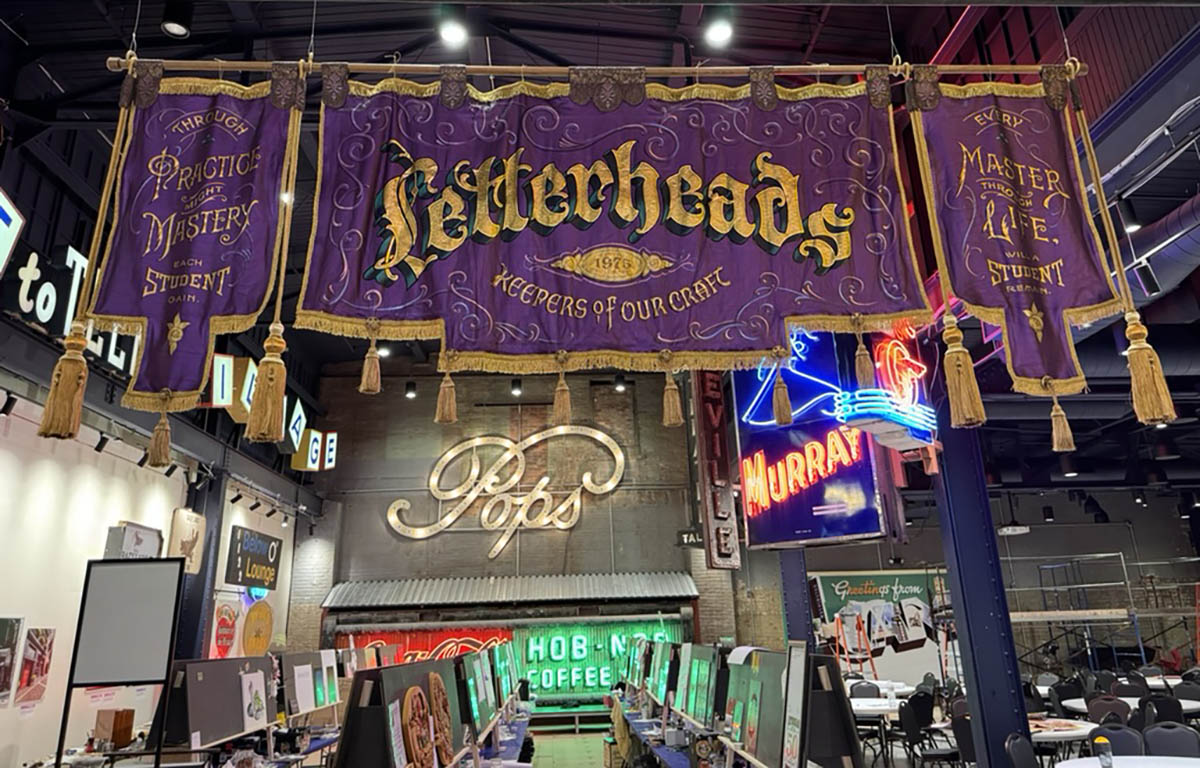
The energy in the central painting hall was electric, with so many talented sign painters from all over the world working side by side on their masterpieces.

The halls of the American Sign Museum are lined from ceiling to floor with historic signs from all eras, from Neon to hand-painted classics.
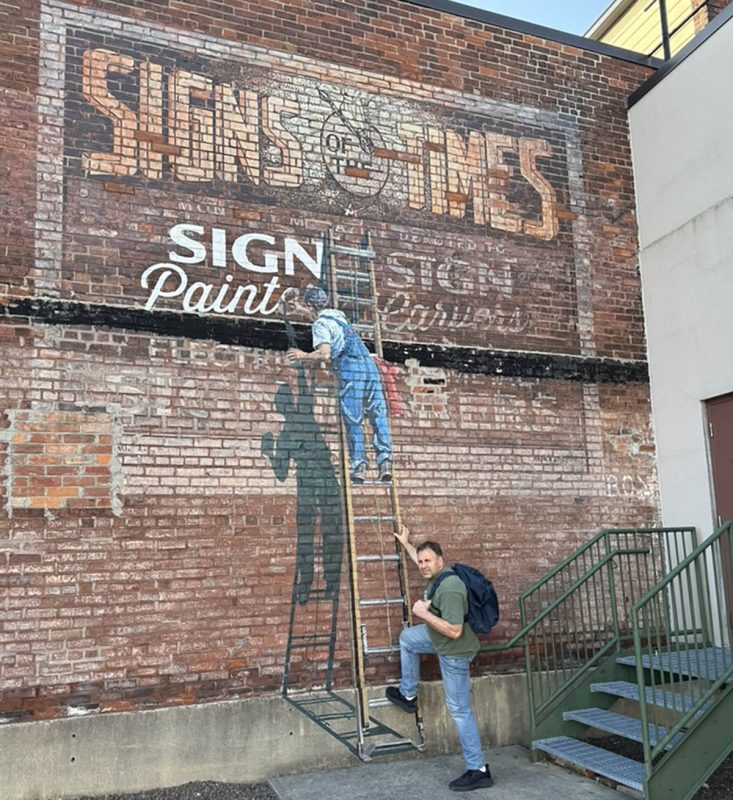
Signs of the Times magazine was so influential and integral to my development as a Sign Painter, and this photo is an excellent representation of their influence.
One of the many great murals that cover the walls of the American Sign Museum
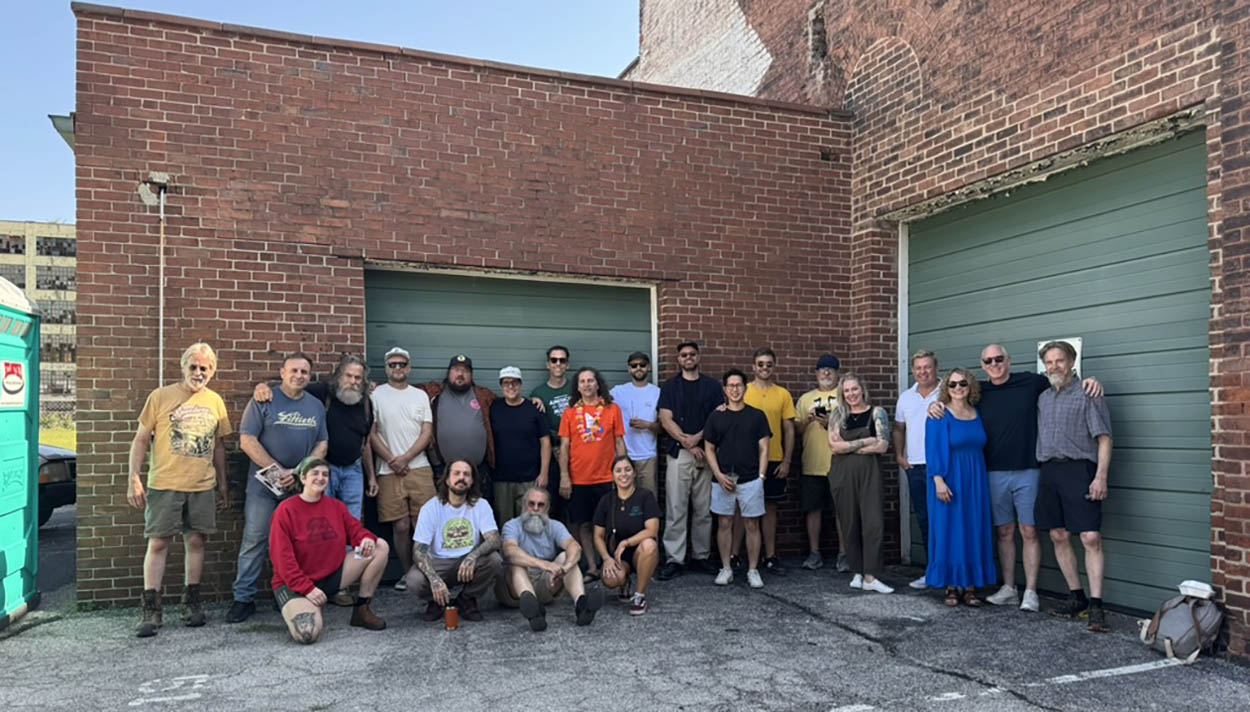
Some of the many great people who made this event such a huge success.

Some of my great friends and colleagues from Left Bob Behounek, Noel Weber and me.

I even got time for a friendly tussle with long-term friend and mentor David Butler as we celebrated the completion of our screen-printed posters for the event.
To celebrate the 50th Anniversary, there were a lot of bonus offers and celebrations being offered at the event. I offered every attendee a one-time 10% exclusive discount on all my courses during the Letterheads event.
Special Offer
In recognition that so many people were unable to attend this incredible event in person, I am extending this 10% exclusive discount offer as a one-time bonus for members of my community and readers of my blog.
Letterheads 50 Limited Discount Offer
10% Off All My Courses
Use Discount Code: LH502025
Expires 30 November 2025

The Start Of Our Tour And Seeking Out Ghost Signs
After a fun but exhaustive Letterheads meet, from the museum, my nine fellow travel buddys Jeff Lang (Our Driver and Guide), Andrew Paul (Also A Guide), Will Lynes, Vi Luong, Nic Caruso, Andy Wright, Karen Wright, Eddy Artist and Jason Skinner and, I piled into a minibus for what would become the start of our official road tour on a destination to New York City.
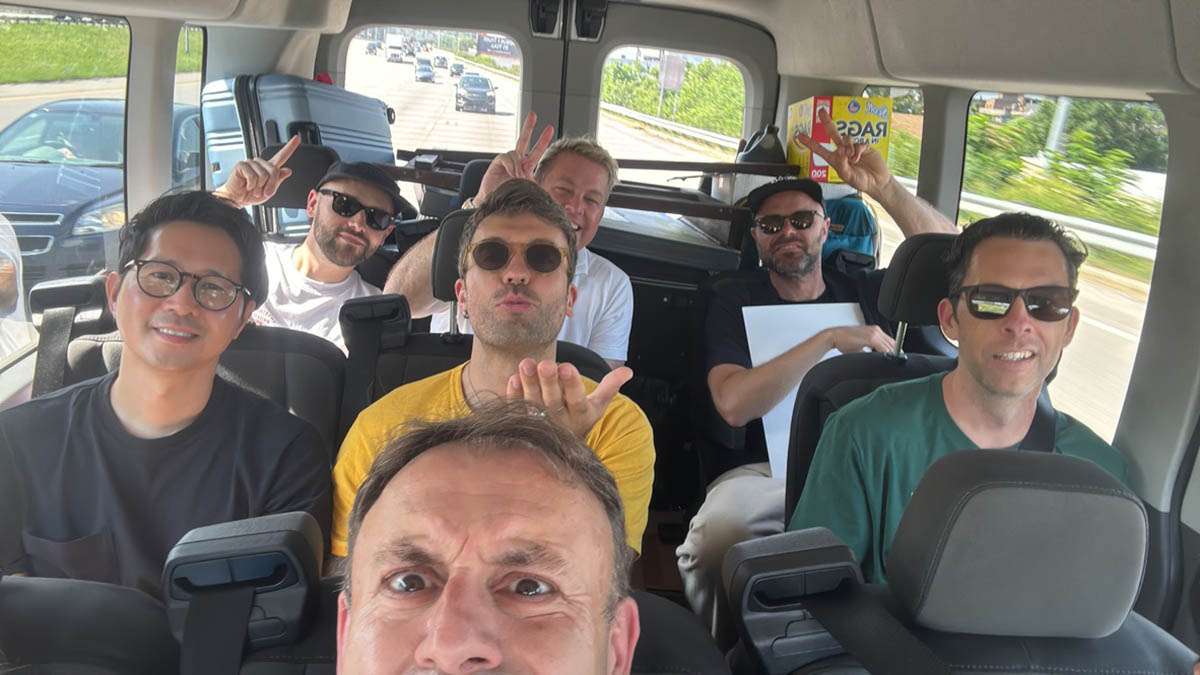
Starting with a ghost sign expedition through Cincinnati’s historic neighbourhoods, we went hunting for the many historic signs that cover the building walls of Cincinnati. These weathered advertisements, painted directly onto brick walls decades ago, are more than just marketing artifacts—they’re reminders of just how highly skilled the master tradesmen of the era were, and the depth of quality, bold, confident lettering that we modern signwriters strive to emulate today.
Our guides (Jeff & Andrew) knew exactly where to go, pointing out the many historic signs that cover the walls of Cincinnati’s Historic landscape.
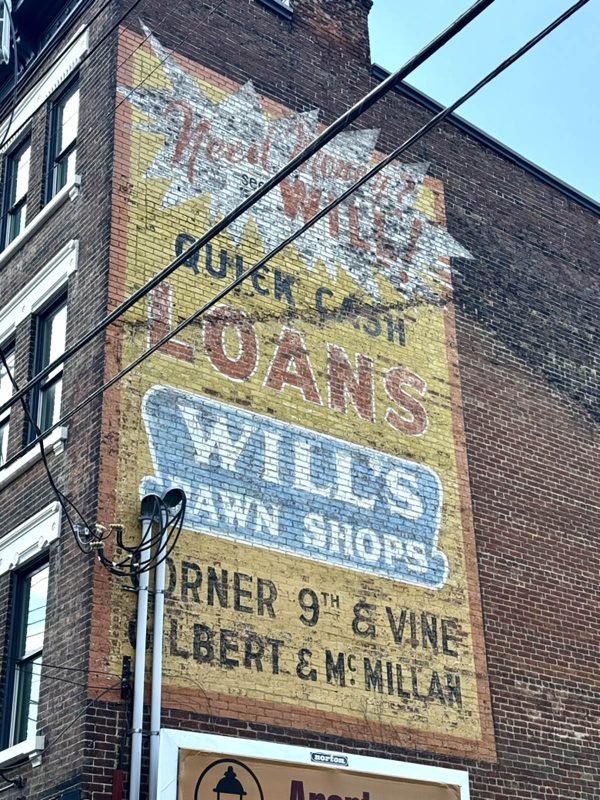
Pittsburgh: Where Craft Meets Innovation
Our journey continued over 460 km from Cincinnati to Pittsburgh, where our first stop was the Pittsburgh Glass Centre.
The team at Pittsburgh Glass Centre gave us a guided tour, revealing state-of-the-art equipment working alongside century-old methods, creating an environment where innovative craftsman can take up residency, exploring their skills in all forms of glass art.
It’s well worth a visit if you find yourself in Pittsburgh.
The evening brought us to the Pittsburgh Lettering Club at Andrew Paul’s Studio. But not before a stop in for afternoon drinks at Lorelei Restaurant. These guys were amazing. They opened the restaurant, especially for us, and their hospitality was endless. I highly recommend checking them out if in Pittsburgh.
Andrew graciously opens his Studio every second Tuesday evening for lettering club, where the city’s signwriting community gathers to paint, discuss, and share ideas. There’s something magical about watching a room full of artists work, talk and laugh while focused on their creativity and practice. It was also another high-energy event.

Andrew’s Studio is a beautifully well-organised space, and we had a fantastic amount of fun joining in and meeting the members of the lettering club. I even had time to design a tattoo for Jill, one of the lettering club members, while I was there. LOL
Another Day, Another Studio Visit
Of course, we couldn’t leave Pittsburgh without a visit to our driver and guide, Jeff Lang’s Sign Studio Olde Lang Signs.
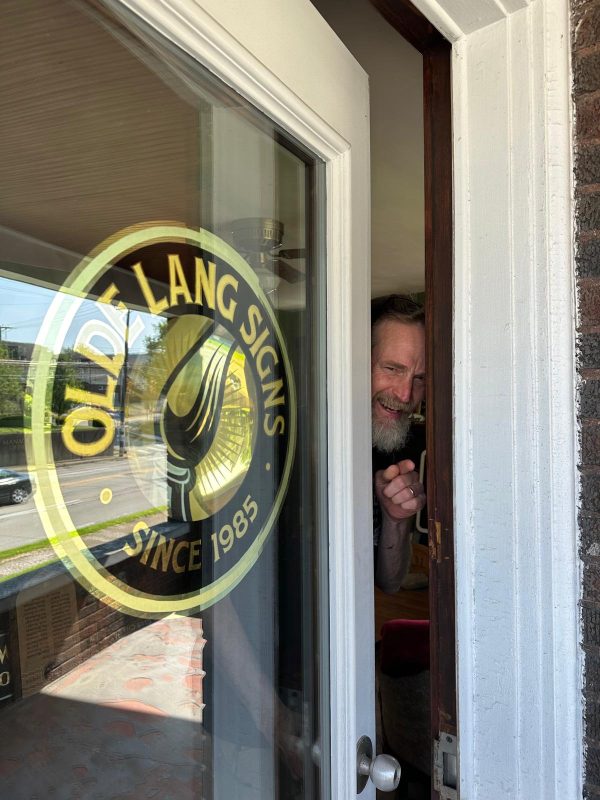
From the moment you walk in the door of Jeff’s Studio, you are met with an inspirational collection of some of the best gold-gilded glass signs around.
Jeff is a master craftsman, and his collection of work is on display as a testament to his precision and skill with the brush.
We were so privileged to be able to visit his Studio and witness his quality artistry first-hand.
It is truly inspirational to be around his work.
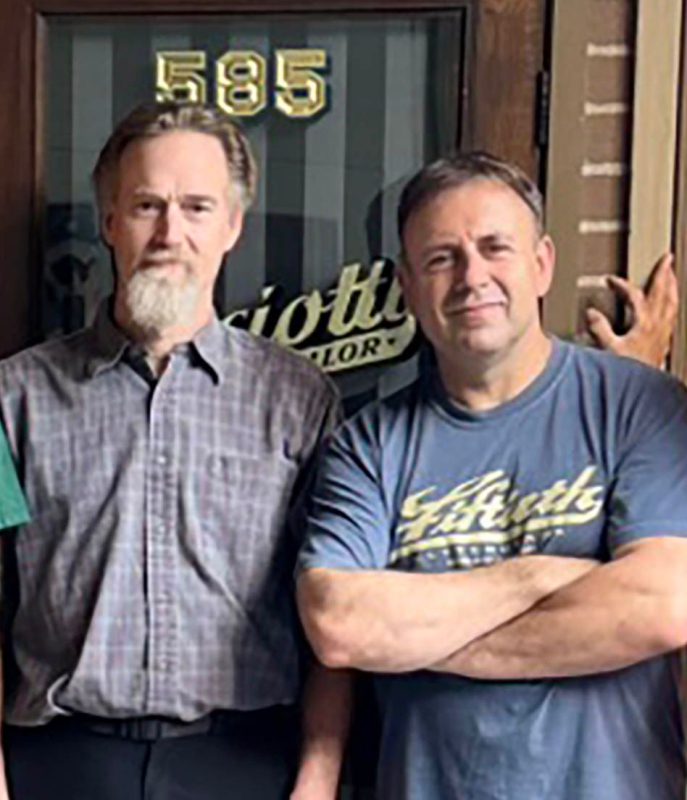
Brooklyn: Where Tradition Meets the Modern City
After Pittsburgh, we headed to the heart of Brooklyn, settling into what could politely be described as our “characterful” Airbnb for two nights (It was a real and shocking eye-opener LOL). The accommodation may have been seedy and questionable, but our hosts in Brooklyn’s signwriting community were anything but.
Our first stop was the team at Noble Signs, a studio that doubles as a museum of New York signage history. Noble Signs has an incredible space nestled in Brooklyn where they create new modern signs amongst their ever-growing collection of vintage signs from New York’s rich and colourful sign history, which indeed tell the story of the city’s commercial evolution.

The museum portion, called the New York Sign Museum, showcased everything from hand-painted signs to large-scale electric and Neon signs that once graced every storefront in Manhattan.
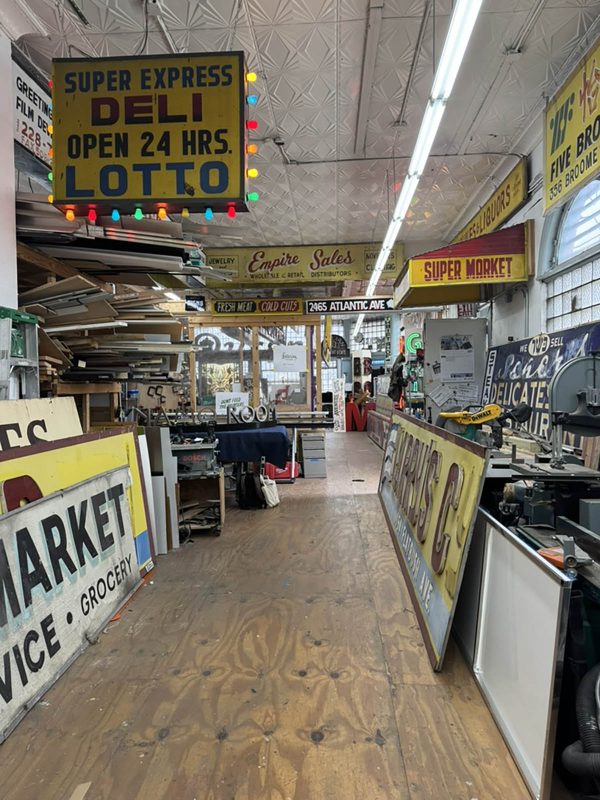
What made Noble Signs particularly special was their understanding of context. They didn’t just preserve old signs; they understood why those signs worked, what made them effective, and how those lessons and techniques could be applied to the work we create today.
The team was extremely accommodating, and I highly recommend visiting them if you’re in the Brooklyn area.
From Noble Signs, we visited Will at Van Zee Sign Co., where we found more beautiful examples of how traditional techniques can thrive in modern times. Will’s Brooklyn studio is compact but extremely clean, efficient, and well-organised.
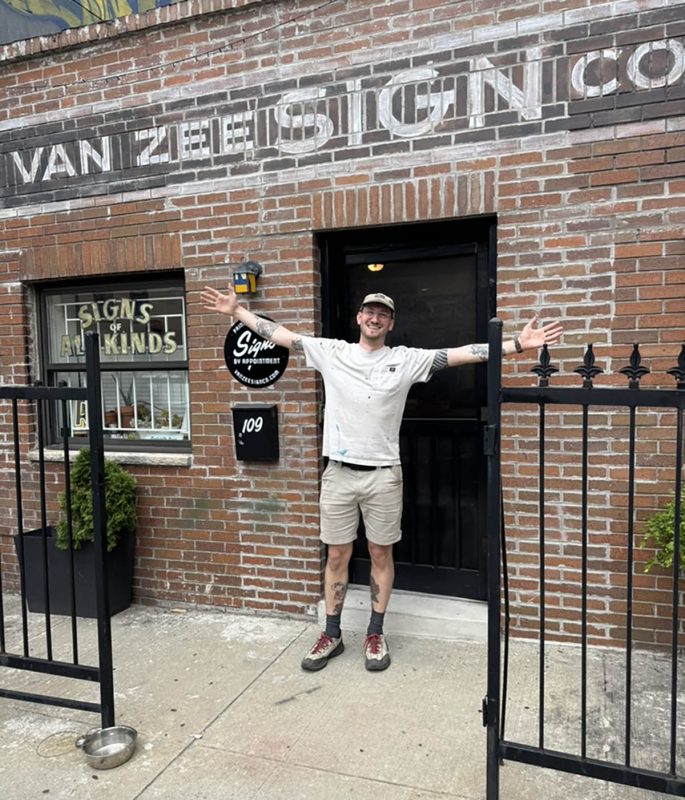
Will’s approach to glass gilding particularly impressed me. His work demonstrated the kind of precision and attention to detail that comes from truly understanding the craft — not just how to apply gold leaf, but how to prepare surfaces, how to work with different types of glass, and how to achieve the kind of finish that will stand out from the crowd. These are the very techniques that I cover extensively in my online glass gilding courses, but seeing them applied in Will’s Studio was brilliant to experience.
Colossal Scale: The Art of the Mural
Our next stop provided a complete change of scale: Colossal Media, the company responsible for hand-painting large-scale mural advertising on skyscrapers throughout New York City. The tour of their workshop and studios revealed an operation that brings traditional signwriting techniques to truly massive scales.
Watching the Colossal Media team work was like observing a master class in project management, rigging and scaffolding, technical skill, and artistic vision all rolled into one. These New York artists work with the same fundamental techniques that any glass gilder would recognise —careful preparation, precise application, and attention to environmental conditions—but they apply them to surfaces that can be seen from miles away.

The workshop tour revealed an impressive array of tools and techniques, scaled up to mural proportions, and modern lifting equipment that allows artists to work safely at extraordinary heights. But what struck me most was how the fundamental principles remained unchanged: quality work starts with good preparation, quality materials do make a difference, and there’s no substitute for fully understanding and investing in your craft.

The Colossal Media experience was also a powerful reminder of why traditional signwriting skills matter in our digital age. In a world of vinyl graphics and digital printing, hand-painted murals command attention precisely because they’re crafted by human hands. They carry the subtle imperfections and personal touches that make them feel authentic and alive, which is why their high-end corporate clientele, including Rolex, Cartier, Coca-Cola, and other high-end brands, is willing to invest millions of dollars in hand-painted signs to market their products.
It was a solid reminder that traditional sign painting is far from dying.
The Emotional Return: Ludlow and Blunt
Our final stop provided the most profound moment of the entire tour. Four years ago, I completed one of the most challenging projects of my career: an intricate glass gilding piece for Ludlow and Blunt Barber Shop in Brooklyn. This piece took me four very long, painstaking years to complete. I invested so much of my life and time into his piece, often missing important family occasions, working all hours of the night and weekends, and today was the first time I was to see it since its installation. Walking back into that space was a truly overwhelming, unforgettable emotional experience.
You can watch the documentary about it here. The making of Ludlow And Blunt

The moment I stepped through the door and saw my work boldly shining back at me —every precise detail exactly as I had envisioned it four years earlier—I was overwhelmed by a flood of memories and emotions. I recalled the countless hours of meticulous work, the technical challenges I had overcome, and the moments of doubt when the project’s complexity seemed overwhelming.
More than nostalgia, what I felt was immense pride in fulfilling such a commission. The piece had not only survived four years in its environment; it had thrived. The gold leaf still caught the light with the same brilliance, the lettering remained crisp and clear, and the overall composition continued to command attention just as I intended. This is what correctly executed glass gilding can achieve: not just temporary beauty, but lasting impact.
Standing there, I was quickly reminded of why I am so passionate about teaching these techniques. Glass gilding isn’t just about applying gold leaf to glass; it’s about understanding materials, respecting processes, and creating work that will stand the test of time. It’s about joining a tradition that stretches back centuries while adding your own voice and ideas to the craft.
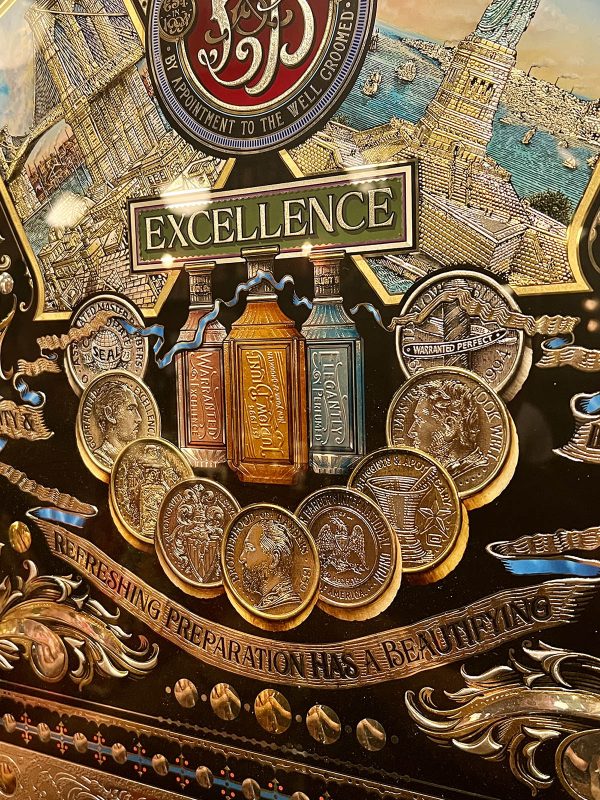
The detailed work that had consumed so much of my time and attention was still there, still perfect, still telling the story I intended to convey. It reinforced my belief that there are no shortcuts in this craft, no substitutes for proper technique, and no replacements for the kind of deep understanding that comes from years of practice and study to master any skill.
Lessons from the Road
As our tour came to an end, I found myself reflecting on the common threads that ran through every stop on our journey. Whether we were examining ghost signs in Cincinnati, watching contemporary work being created in Pittsburgh, or marvelling at large-scale murals in New York, certain principles remained constant.
First, craftsmanship matters. In every Studio we visited, in every piece we examined, the difference between good work and great work came down to attention to detail, respect for materials, and commitment to proper traditional techniques.
These aren’t optional extras—they’re the foundation of everything we do.
Second, community is essential. The letterheads gathering, the Pittsburgh Lettering Club, and the collaborative spirit we found in every Studio—these reminded me that traditional crafts survive through sharing, teaching, and mutual support. We’re not just individual craftspeople; we’re part of a living tradition that depends on all of us for its continued growth and future longevity.
Third, learning never stops. Even the most experienced signwriters we met spoke about continuing to discover new techniques, new applications, and new ways of thinking about old problems. The craft stays alive because it continues to evolve, and it evolves because practitioners remain curious and open to growth.
The Future of Glass Gilding
This tour reinforced my firm belief that traditional signwriting and glass gilding techniques are not just surviving in our digital age—they’re thriving. They are thriving because dedicated craftspeople are discovering new ways to share knowledge, exploring new applications for traditional techniques, and there is an increasing demand for bespoke work that embodies soul and quality.
The online learning platforms available today allow students from around the world to access quality instruction from their own homes. The social media communities that connect isolated craftspeople, along with modern tools, make traditional techniques more accessible.
During our tour, I was amazed by how many talented signwriters at all levels I met who weren’t aware of the online glass gilding courses I’ve developed to help fast-track their gilding skills and success. It reminded me of the importance of making these techniques accessible to anyone with the passion to learn, regardless of their geographic location or current skill level.
My Introduction to Glass Gilding course provides the fundamental knowledge that every beginner needs to get started properly. In contrast, my Advanced Glass Gilding course takes students deep into the professional techniques that can transform good work into great work. Both courses are designed to provide the kind of thorough, systematic instruction that was once only available through lengthy traditional apprenticeships.
The future of glass gilding lies not in choosing between traditional and modern approaches, but in finding ways to combine the best of both. Online learning can provide the theoretical foundation and technical knowledge, while hands-on practice develops the intuition and skill that separate craftspeople from artists.
A Continuing Journey
As I write this back in my own Studio, surrounded by the tools and materials of my trade, I’m filled with renewed enthusiasm and excitement for the work we do.
The Great American Glass Gilding and Traditional Signwriting Tour of 2025 was a journey through time, connecting me once again with the roots of our craft while shining a torch on its future.
The ghost signs of Cincinnati reminded me that our work can outlast its creators. The studios of Pittsburgh and Brooklyn showed me that traditional techniques can thrive in modern settings. The emotional reunion with my work at Ludlow and Blunt proved that the continued investment in learning new skills, honing those skills and executing them correctly can create something truly unique and timeless.
Most importantly, the entire experience reinforced my belief in the importance of sharing knowledge, building community, and keeping these traditions alive for future generations. Whether through formal education, online courses, or informal mentorship, we all have a responsibility to pass on what we’ve learned.
The tour is over, but the learning continues. Every day in my Studio, I’m reminded of the valuable lessons learned on our road tour. The techniques observed and shared in other craftspeople’s studios, alongside the ongoing dialogue between the past and future techniques, will shape the future of our craft.
The craft of glass gilding is alive and well, practised by passionate craftspeople around the world, preserved in museums and workshops, and passed on through both traditional and modern methods of instruction. It’s a craft that rewards patience, precision, and dedication—but the rewards are worth every hour of practice.
As I look at the tools on my workbench and the pieces in progress around my Studio, I’m reminded that we’re not just signwriters or gilders—we’re custodians to ensure a future where craftsmanship and human skill continue to matter.
The Great American Glass Gilding and Traditional Signwriting Tour of 2025 is complete, but the journey continues every day in studios, workshops, and classrooms around the world.
Let’s ensure these traditions live on.
David A. Smith MBE
Are you ready to begin your own personal journey in glass gilding?
Remember to take advantage of my one-time Limited Letterheads 50 Celebration Discount offer.
Letterheads Limited Discount
10% Off All My Courses
Use Discount Code: LH502025
Expires 30 November 2025

Explore my comprehensive online courses designed to take you from beginner to professional:
Introduction to Mastering the Craft of Glass Gilding – Perfect for beginners who want to learn the fundamentals properly from the start.
Advanced Glass Gilding Course – Designed for experienced practitioners ready to master professional techniques and achieve exceptional results.
Join the tradition. Master the craft. Create work that lasts.





Sean Michael Felix
Great article Dave!
Keep on keeping on brother!!
Kevin Lee Clark
I really enjoyed the article. Wish I could have been there. @kevinleeclark